Who was F & C Osler?
F & C. Osler was a company established in Birmingham in 1807. They are revered for their superb glass-cutting and blowing, which was second to none. Their glass was rarely marked although many designs are registered, but the metal mounts on fittings are often stamped F. & C. Osler. Stamped or not, the stunning cut of the glass has a look and feel instantly recognisable as ‘an Osler’ .
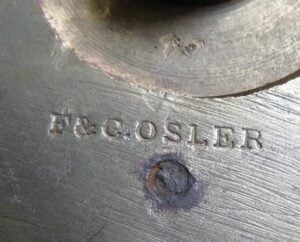
F & C. Osler stamp on a metal lamp base
Osler started in the humble ‘Glass Toy Trade’ making trinkets and ornaments. A new customer requested a large order for some Icicle drops which, proving rather more lucrative than trinkets, encourage Osler toward making Glass Chandeliers and other important work. The early 19th century was not an easy time to trade in glass due to the heavy duty levied on it. An Exciseman was present on a daily basis to ensure all duty was paid and, consequently, illegal trade put manufacturers at a great disadvantage.
Mr Thomas Osler was a scholar rather than businessman and it was not until his sons (Follett and Clarkson Osler) came into the business injecting energy and resource that things took off and a London house was opened in 1845. The commission by the ruler of Egypt (Ibrahim Pacha) for a pair of enormous Candelabra to place beside the tomb of the prophet Mahomet at Mecca lead to much interest and Messrs Osler had the honour of a visit from HRH the Prince Consort. A second, even greater Candelabrum was designed and exhibited at the Exhibition of Industrial Arts in Birminghan, opened by the Prince Consort. It was this exhibition which gave Prince Albert the idea of a Great Exhibition in London.
The date was set and Mr Osler pretentiously agreed with the Commissioners to make something ‘really worthy, for which the cost and labour would not be worthwhile if it is to occupy a secondary place’. A year and a half later the huge, Gothic fountain, made entirely of pure crystal glass was completed and stood in the centre of the building.
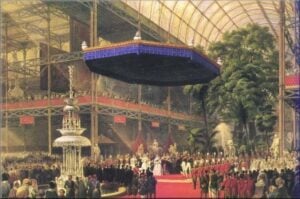
The Crystal Fountain at the opening of The Great Exhibition (switched off for Queen Victoria to speak)!
The Crystal Fountain caused a huge sensation at the time. It became the meeting place at the Exhibition, arousing much press interest and further enhancing F & C. Osler’s growing reputation. The brochure for The Great Exhibition describes the fountain and goes on to say that it, ‘..is perhaps the most striking object in the Exhibition; the lightness and beauty, as well as the perfect novelty of its design, have rendered it the theme of admiration with all visitors.’
In the latter half of the 19th century Osler were highly successful with showrooms in Birmingham, London and Calcutta. Despite the glamour of the fountain, the ornate thrones and multiple table wares, it was lighting which made their reputation. Osler’s stunning chandelier designs have a geometric feel to them. They were highly innovative, especially in their ability to enhance the beauty of cut glass using contrasting metalwork.
F. & C. Osler were leaders in their field and took the art of ‘Brilliant Cut Glass’ to new heights. The ‘brilliant’ style emerged by the late 1870′s, its name aptly describing its effect. At its most complex brilliant cutting involved covering the glass surface with intersecting cuts that created innumerable, often fragmentary shapes making up larger patterns. Basic motifs used were stars, hob-nail or polygonal diamonds, strawberry diamonds and fan scallops, out of which a dazzling surface effect was achieved.
The wealth within India and efficient shipping links led Osler to chose India as his largest market outside the UK and many Osler chandeliers and light fittings survive there to this day.
Here are just a few examples of Osler lighting we have been privileged to pass on to new homes via our shop:
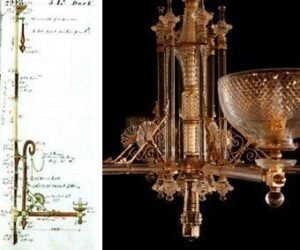
Registered design drawing next to detail of the Osler Chandelier in all it’s glory
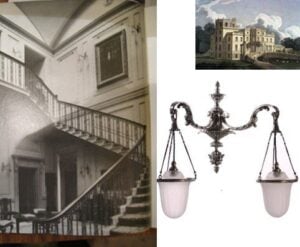
We relocated this set of 23 superb Osler wall lights from Dunglass House, East Lothian to a remote castle in the Orkneys.
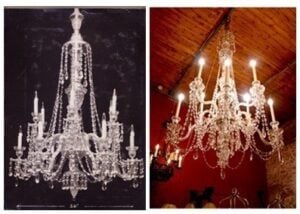
1905 Original Osler catalogue & the Osler Chandelier at Fritz Fryer Antique Lighting 2011
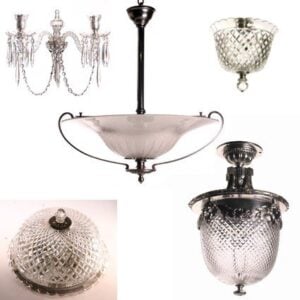
A collection of Osler plaffonier and crystal wall lights from Fritz Fryer Antique Lighting

